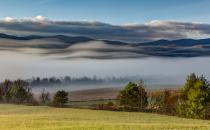SELC op-ed: Great American Outdoors Act is monumental for the South
The Great American Outdoors Act is a historic achievement.
Wear and tear has long been an issue for our public lands—most acutely in our national parks, where the deferred maintenance backlog approaches $12 billion. The monumental passing of this bipartisan bill will promote better outdoor experiences today while ensuring that future generations will have the same special places to enjoy tomorrow.
Anders Reynolds, Federal Legislative Director for SELC’s National Forest and Parks Program, recently penned this op-ed for Blue Ridge Outdoors that illuminates the significance of the passing of this act.
Read an excerpt of the piece below, or click here to read it in full.
Historic Great American Outdoors Act becomes law: A monumental step for the future of public lands in the South
Access to public land is the birthright of every American. Our parks, monuments, forests, and wildlife refuges offer places for respite, for recreation, and for the remembrance of the challenges and opportunities we’ve faced as a nation. As a common good, they’re also an exercise in humility, requiring us to make responsible decisions about how we’ll manage these precious natural resources for future generations.
But the current pandemic has put increased pressure on those resources and all the communities that rely on them for clean water and tourism dollars. While getting into the outdoors can be a true escape, a wonderful antidote for cabin fever, and a chance to reconnect with nature, it can also put a terrible strain on gateway communities and the resource we’re trying to protect. In fact, wear and tear has long been a problem for our public lands, most acutely in our national parks, where the deferred maintenance backlog approaches $12 billion.
…
The bill itself is a marvel written in two movements. Its first part permanently dedicates $900 million of oil and gas revenues each year to the Land and Water Conservation Fund (LWCF). This program is used by the federal land management agencies to expand public lands for purposes of recreation, while supporting a number of conservation programs, like the U.S. Forest Service’s Forest Legacy Program which incentivizes private landowners to adopt sustainable management practices rather than convert their land to non-forest uses. It also provides grants to states so that they may develop more local parks and playgrounds.
This last point is an important one, as questions of privilege have always beset conversations about who defines “authentic” outdoor adventure-making, and who (particularly in times of crises) should benefit from access to green space. This bill ensures that people stuck in cities have access equitable to those who can afford to escape them.
…
The second part of the Act commits nearly $10 billion over the next five years to address the maintenance backlog in our national parks. These funds will be used to address crumbling infrastructure and the deterioration of other visitor experiences in places like the Great Smoky Mountains National Park, which, as the most popular national park in the United States, has been loved to death to the tune of $233 million in deferred maintenance.
They’ll also help the Park Service to fix up Shenandoah Park’s Skyline Drive, the Big South Fork National River and Recreation Area, and the Selma Interpretive Center at the foot of the Edmund Pettus Bridge.
Our national parks and public lands support the economies of our local communities while preserving sensitive ecosystems and habitats from over development. They also provide outstanding recreational opportunities — not just for tens of millions of outdoor recreation enthusiasts, but for countless people who simply need a break from being stuck at home and want to take a walk along a trail by a nearby river, never considering that they too are “conservationists.” It’s past time we devoted the appropriate resources to their upkeep.

